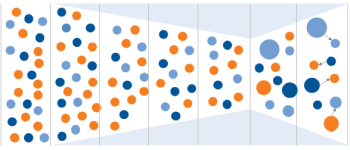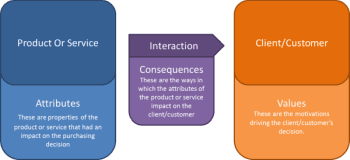The difference between qualitative and quantitative research is a fundamental distinction within research practice. Below, we outline how "qual" and "quant" data vary, and the implications for market researchers.
What is quantitative research?
Quantitative research is concerned with measurement of a market or population. Within market research, this may include, but is not limited to:
- Market sizing: For instance, estimating market sizes through asking questions about purchasing patterns, frequencies and future buying intent
- Measuring brand health: e.g. measuring brand awareness, consideration, usage and advocacy. This often involves monitoring responses over time in order to test the efficacy of a brand’s sales and marketing efforts
- Market segmentation: Grouping customers and prospects in a market according to shared attitudes, behaviors and/or needs. In order to robustly ascertain this, large numbers of responses are often required.
- Customer satisfaction surveys: Especially to measure customer loyalty and satisfaction levels over time, or on different aspects of an organization’s products and services.
- Advertising effectiveness research: For instance, measuring the impact of a market campaign on advertising awareness or brand associations by taking a measurement before and after the campaign (also known as pre- and post-testing)
A quantitative research technique will be used where a stable and representative measurement of the market is required.
Stability is important where research needs to be repeated or where changes must be detected over time. Due to the nature of survey sampling, researchers need to think about margins-of-error, as this might affect reporting. Increasing a sample size is a good way to reduce the level of error.
Representativeness is very important where market research is to be used to support business decision-making. Quantitative research conducted on random-sampling is well-suited to this task. Sufficiently large, quantitative samples are able to cover a wide, representative cross-section of the market.
What is qualitative research?
Qualitative information is harder to define but the emphasis is on ‘understanding’ rather than simple measurement. For example, quantitative research may tell you that Advert A is recalled more often than Advert B. However, quantitative feedback alone does not help to diagnose how Advert A works or why it is more effective than Advert B. This is when qualitative research is needed.
Qualitative research involves empathizing with the customer. It helps to establish the meanings the customer attaches to products, brands and other marketing devices. Another focus is motivation: For example, what are the needs that customers expect to be met? And why does one product meet these requirements over another?
Qualitative research is conducted among smaller samples compared to quantitative research. In the case of attitudes to brands, for example, qualitative research may determine a specific view held about the brand, whereas quantitative research would tell us what proportion holds that view.
Examples of qualitative research methods used in market research include:
Each technique has its own specific advantages, depending on the nature of the target audience and the type of information that needs to be collected. For instance, while techniques such as interviews rely more on direct questioning of research subjects, ethnographic studies are predicated on observation.
Qualitative vs. quantitative research: Not always a straightforward choice
Quantitative and qualitative research work in tandem. The qualitative element frequently takes place at the beginning of the study, exploring values that need measuring in the subsequent quantitative phase. In this way, qualitative research can help to improve the usefulness and efficacy of quantitative research studies.
Qualitative research may offer a diagnostic understanding of what is wrong, while the quantitative research provides hard data across different respondent groups that can lead to specific recommendations with measures that can be used as controls to determine the effectiveness of actions.
A professional market research company will take care in designing a research study to align the most appropriate techniques with the research objectives. Of course, there are also practical considerations around which methods to use: In more niche business-to-business industries, the number of target organizations may be limited. In such cases, qualitative methods may be the only feasible means of conducting the research.
In the table below, we outline some of the typical characteristics of these different research methods:
| Characteristic | Qualitative market research | Quantitative market research |
|---|---|---|
| Is well suited to… |
|
|
| Sample sizes (number of interviews, observations etc.) | Small numbers – Frequently fewer than 100 responses | Larger numbers – Survey sample sizes are often in the 100s or 1000s |
| Time taken | Dependent on sample sizes, but simple qual studies can be completed in days or just a few weeks | The fieldwork phase for quant studies may take many weeks or months to complete |
| How the data is reported | Data are presented thematically, capturing the main "stories" behind the data. Individual responses in the form of videos, quotes and audio are often used to demonstrate a specific theme. | Usually charts, aggregated tables and other statistical plots. |




